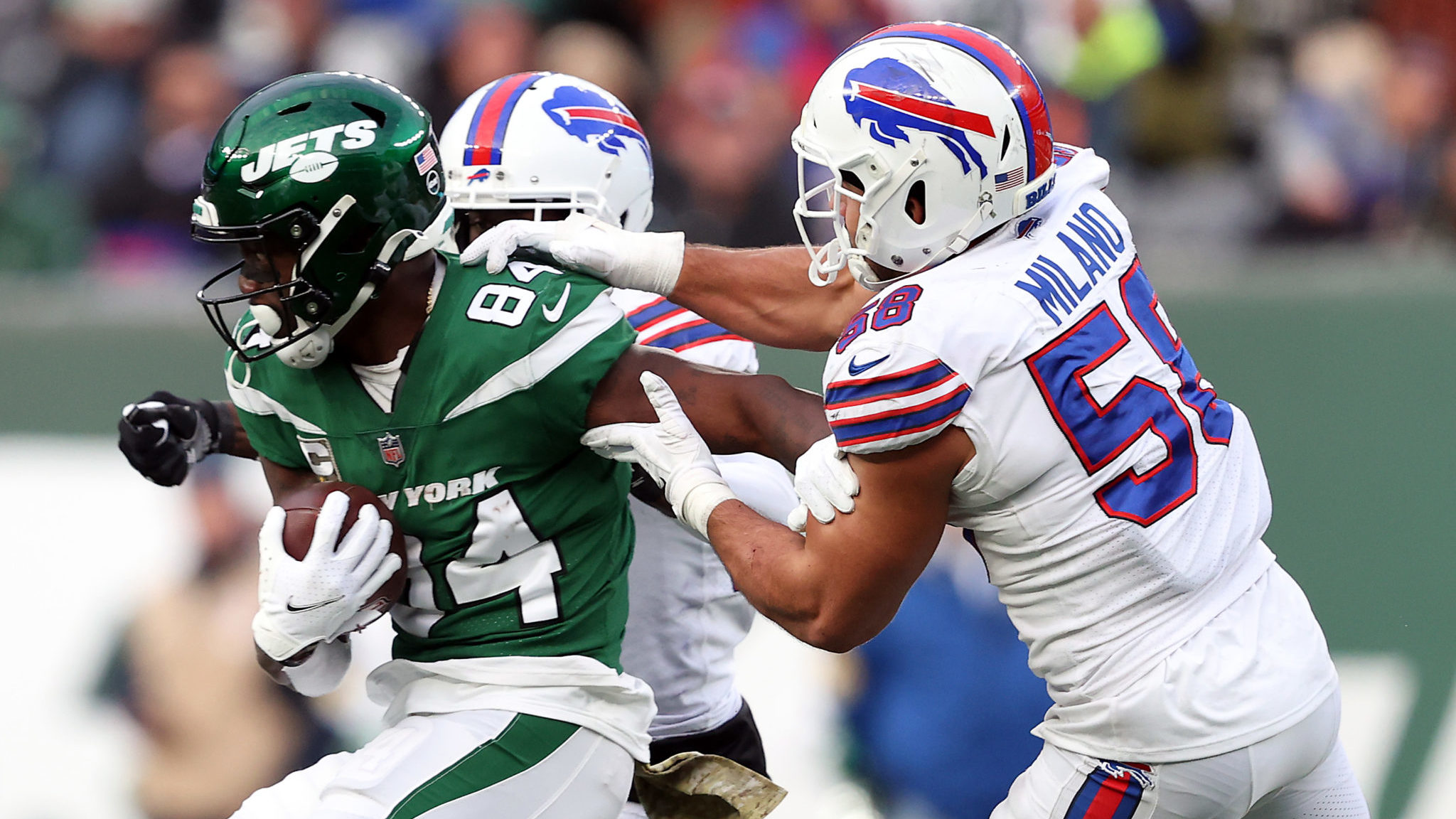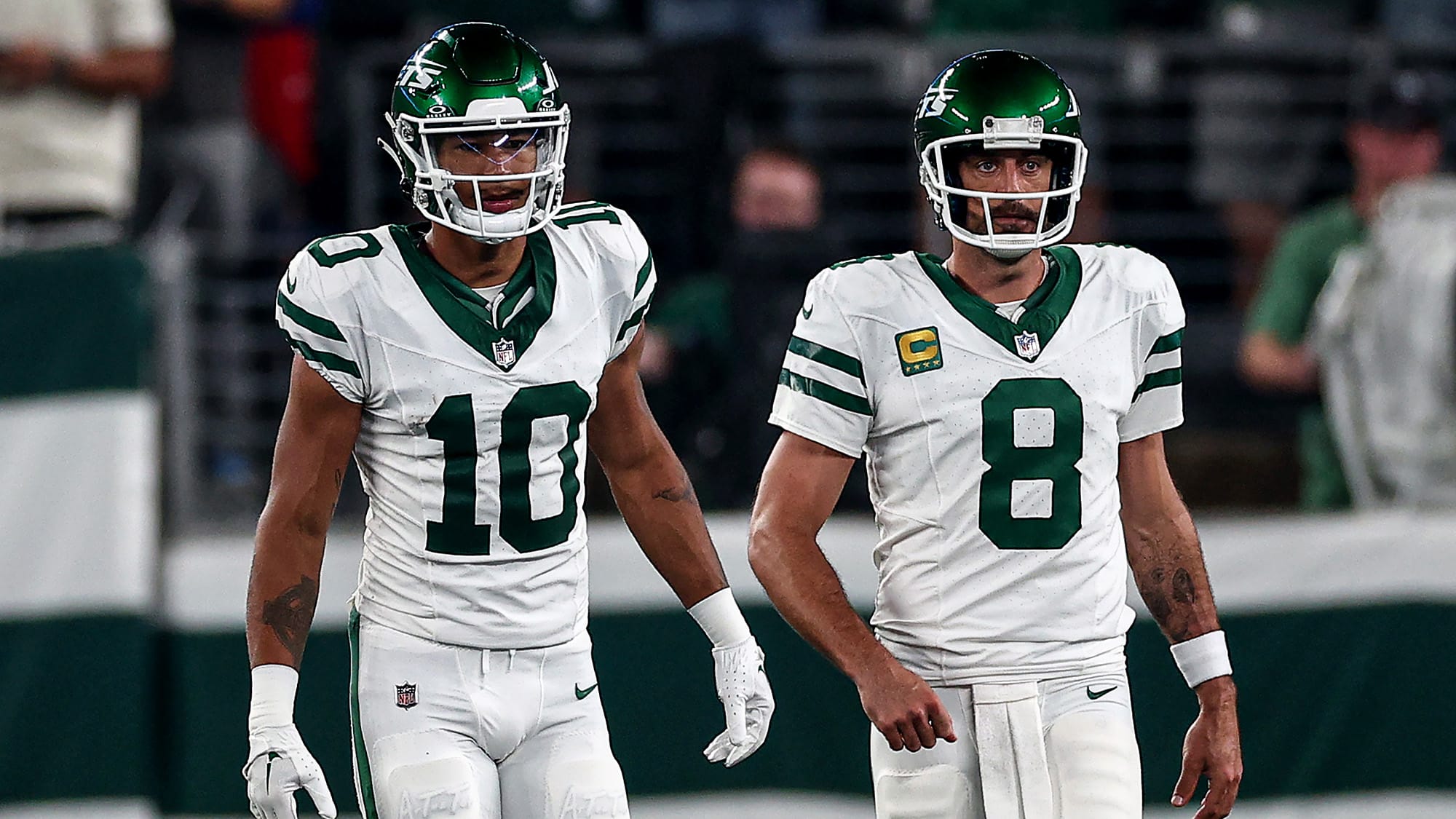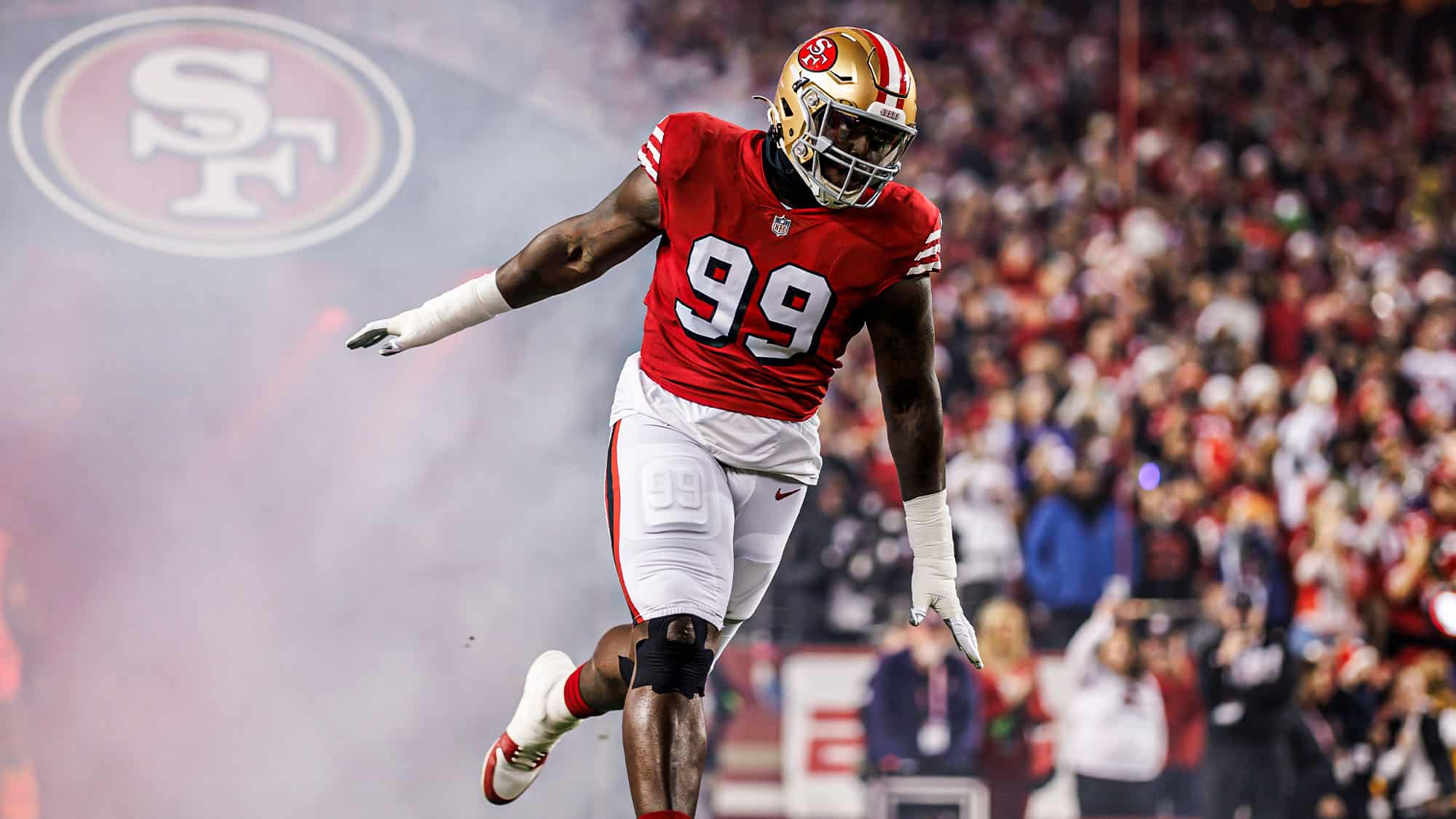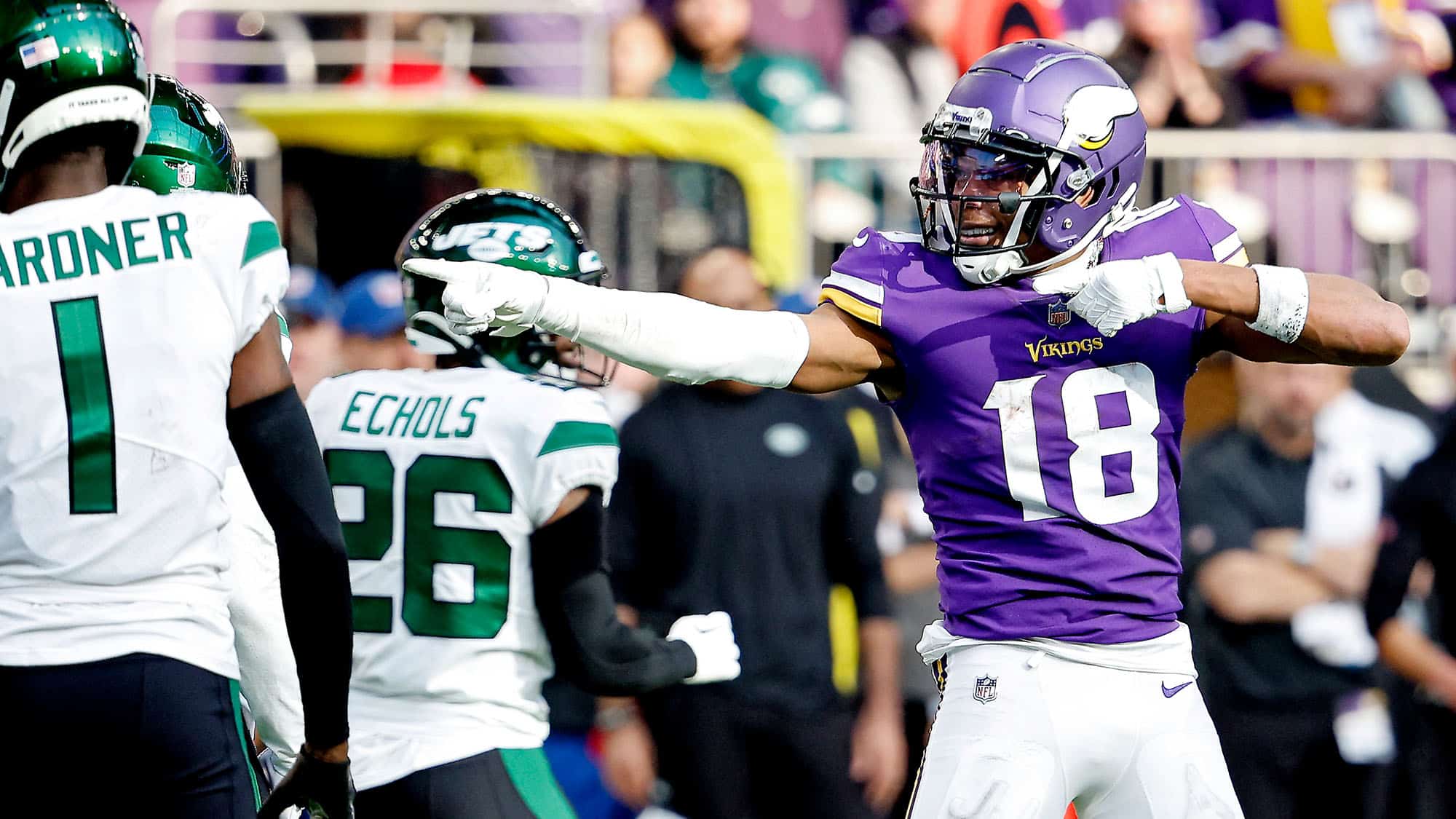Why Jets’ Corey Davis is the perfect No. 2 NFL receiver
Is it okay for a big-time free-agent signing to comfortably slide into a No. 2 role?
The answer depends on many factors.
When the New York Jets signed Corey Davis to a three-year, $37.5 million deal last offseason, fans had mixed reactions. Davis was coming off the best season of his career in which he posted 65 receptions, 984 yards, 5 touchdowns, and an 86.9 Pro Football Focus grade.
Still, his name as a first-round bust had gotten out across the league. Some believed that without A.J. Brown to leave him with one-on-one matchups, Davis would struggle.
Indeed, Davis’s first year with the Jets was disappointing.
In nine games, Davis registered 34 catches for 492 yards and 4 touchdowns. His catch rate of 57.6% ranked 78th out of 89 receivers with at least 50 targets. His 15% drop rate was third-worst, with six drops in nine games.
To add insult to injury, five interceptions were thrown on passes intended for Davis, and he also fumbled twice.
In many ways, Davis’s 2021 season was reminiscent of his rookie year with Tennessee. Coming to the Titans as the No. 5 overall pick in the 2017 NFL draft, he posted a 60.1 PFF grade in 11 games with 34 catches for 375 yards and no touchdowns.
Heading into the 2022 season, though, Davis’s role on the Jets projects very differently. Second-round pick Elijah Moore had an excellent rookie year in which he showcased his ability to win matchups all over the field, especially on the outside. The Jets added Garrett Wilson in the first round of the 2022 draft to be another versatile playmaker with smooth route-running and YAC ability.
This leaves Davis back in his 2020 role from Tennessee: the No. 2 receiver. That’s where he thrived previously, and that is where the Jets believe he can thrive once more.
Davis’s career splits in context
It’s easy to give up on Davis after all of the drops he had in 2021. But let’s take a look at some of his career splits for context.
In 65 career games played, Davis has 241 receptions for 3343 yards (13.9 yards per reception) and 15 touchdowns.
Since there has only been one 17-game NFL season thus far (and it is hard to contextualize how much production that extra game should add), let’s take his per-game averages and extrapolate them over a 16-game season: 59 receptions, 823 yards, and 3.7 touchdowns.
Moreover, if you extrapolate Davis’s 2021 numbers over 16 games, you get a similar stat line: 60 receptions, 875 yards, and 7 TDs. This is more an indication of how often Davis was targeted than how well he actually played, but it takes some of the ugliness out of Davis’s overall stat line.
Other than his career TD number, would Jets fans not sign up for career-average production from Davis in 2022?
There is the argument that 59 receptions are a bit low for a No. 2 receiver on a team that had A.J. Brown and no one else. That’s not entirely accurate considering that the Titans were a run-first offense for all four seasons that Davis was there.
It is completely justifiable to have been underwhelmed by Davis’s performance in 2021. Still, even Davis put up enough production to be decent if he had not missed so many games due to injury.
Davis has made the most of his receptions over the course of his career. His 13.9 yards per reception would have been in the 72nd percentile of receivers with at least 60 targets last season (covering approximately each team’s top three targeted receivers). That means that his career average is better than about three-quarters of starting NFL receivers based on 2021 averages. Davis gets depth on his targets, which is ideal for a No. 2 receiver.
Furthermore, even in Davis’s subpar 2021 season, his 1.74 yards per route run (YPRR) ranked 34th out of 89 receivers with at least 50 targets, which is in the 62nd percentile. He continued to make his catches count. In 2020, he was near the top of the league, ranking fifth among 84 receivers with 2.58 YPRR.
Davis’s career catch rate of 60.7% is not great. It would have ranked in the 19th percentile of receivers with at least 60 targets last season. However, when you consider that A.J. Brown’s career catch rate is 62.7% (which is what Davis’s is if you remove his rookie year), you have to wonder if some of that is due to quarterback play.
In the one season that Brown and Davis had different quarterbacks, Davis was catching balls from the least-accurate quarterback group in the NFL, while Brown caught the ball from Ryan Tannehill and his 67.2% completion percentage. Still, their numbers remain similar.
There is no doubt that Davis’s drops were a big problem in 2021. However, he has been far more reliable in his career. This raises the hope and expectation that last season was an outlier.
The league-average drop rate in 2021 was 6.6%. Although Davis was at an inordinately high 15% in 2021, his other four NFL seasons produced drop rates of 5.6%, 5.8%, 5.8%, and 6.5%, closely in line with league averages.
In terms of contested catches, Davis has been up and down throughout his career. His numbers range from a putrid 22% in his rookie season to 71% in his 2020 campaign. His career rate is 53.7%, above the league average of 46.4% in 2021. When you exclude his rookie year, that number jumps to over 58%. Although Davis was slightly below league average in 2021 at 46.2%, he was not as terrible as his drop rate indicates.
For his career, Davis is at least average, if not above, on contested catches. That works well with Zach Wilson‘s gunslinger mentality.
Beware hyperbolic charts and statements
Some charts have been circulating in Jets fan circles regarding Davis’s route win rates against specific coverages. These charts say that in 2020 – his best season in the NFL – Davis was below league average (sometimes well below) in getting open on all route types, including against man, zone, and press coverage.
According to Reception Perception, Davis had a win rate of 63.8% against man coverage in 2020, which ranked at the 35th percentile among qualified wide receivers. His 63.6% win rate in zone coverage was even worse relative to average, placing at the 5th percentile. Davis’s 64.8% win rate against press coverage ranked at the 45th percentile.
Those rates would indicate that Davis isn’t good at creating space and getting open. However, given Davis’s size (6’3″, 205), the Jets did not necessarily sign him to create huge amounts of separation. Rather, they want him to be the big target who can win contested balls and make catches in traffic.
There is no doubt that Davis can struggle against press-man coverage. However, since he was the Jets’ No. 1, he was forced to stay at the line of scrimmage. Moving to the Z role will allow Davis to back off the line in most formations, giving him extra time to evade press looks. Even though the Z is often reserved for faster receivers, it can help Davis tremendously.
It seems likely that the Jets preferred Garrett Wilson over Drake London because they felt they already had their big-target, contested-catch guy in the building.
To the slot?
Jets X-Factor has had somewhat of a debate about Davis’s ideal position. Although he is known as an outside receiver, a February article by Vitor Paiva argued that Davis should be moved to the “power slot” position. This would allow Davis to take advantage of his main strengths, namely free-release looks, inside routes, and yards-after-catch (YAC) opportunities.
However, Michael Nania wrote an article explaining why the Jets’ best option at slot receiver is Garrett Wilson. Both Davis and Elijah Moore performed far worse in the slot than on the outside, whereas Wilson thrived in the slot in college. Wilson will most likely be the primary slot receiver.
Still, Paiva’s points about Davis are valid. Although his YAC numbers have been middle-of-the-pack in his career (and were below average last season), Davis would have more YAC opportunities on shorter routes from the slot. He does perform far better when he is not pressed, and his biggest play last season occurred on a free release.
Furthermore, Paiva’s main argument is that Davis would help the run game from the inside. Mike LaFleur‘s offensive scheme relies on receivers blocking, and Davis is likely the Jets’ best blocking WR. His size makes him the most likely candidate to put his head down to block linebackers and safeties.
The team did address their most pressing need at tight end by signing C.J. Uzomah and Tyler Conklin, both of whom can block. Still, Davis can help out of 11 personnel and other groupings, limiting the defense’s clues about the Jets’ play calls.
The great thing about the Jets’ top four receivers is that they are all flexible in a scheme that requires receiver versatility. Davis will get his looks out of the slot, as will Moore, Wilson, and Braxton Berrios. It might behoove LaFleur to coach up some shots down the field to Davis from the slot position.
Can Davis change fans’ minds?
The prevailing narrative about Corey Davis is that not only was he a draft bust, but he was a massive free-agent bust for the Jets.
Although his first season in the Green and White was disappointing, Davis has a chance to completely turn the story on its head with a strong 2022 season.
Davis is no longer stuck as the X receiver. He can get off the line, shift around, and evade press coverage. The Jets do not have to rely on him to constantly win routes but can dial up shots from different places on the field.
Given the explosion of the wide receiver market in 2021, Davis can make his contract appear to be a bargain with a bounce-back year.
If not, the Jets will most likely send him packing as a failed two-year contract with minimal loss. Davis’s dead cap hit next season is merely $667,000.
So can a big-ticket free agent slot into the WR2 position?
If Davis performs well in his role this season and helps Zach Wilson’s development, he will be worth every penny.













No disagreements w/ your points. After watching some pre-season Jets Flight kind of shows last year I really expected Davis to have a great year; he had many personal issues coming out of his time in TN and a new baby and solid family life looked promising. Like Mekhi, I can’t write someone off after one injury-plagued season.
As an aside, the article never flat out states who our “number 1” is, Elijah Moore in his sophomore season?
Davis is a little different than Mekhi, because he actually played nine games and he did not show up out of shape this season. You’re right about Davis’s personal issues; he spoke about how he had not fully processed his brother’s death during the course of last season.
I should have been clearer, but yes, Elijah Moore is the Jets’ No. 1. I think there’s a clear consensus on that among Jets X writers and most of the other analysts and reporters for the team.
He caused a few INT’s last season and it wasn’t good compared to what/why he was brought here. I don’t think he was a “massive free agent bust” after one poor season on a poor team. I feel good about him rebounding but if he doesn’t I think “free agent bust” is an appropriate label. I’m also not sure why they have in mind for this WR group, I think LaFleur is going to have a lot of mouths to feed. They’ve got 2 TE’s they like to have on the field, they will have one back which leaves 2 WR’s for those sets. I am excited to see how he mixes things up. I think Davis will have a good season.
I agree that it’s unfair to label him a free agent bust after one season but would be fair after two poor ones.
I don’t think it really matters which guy gets it done. The Jets can win without a single dominant fantasy contributor because of the multitude of weapons they have. LaFleur has many options. Because they’re so young and not big diva stars, he doesn’t need to be overly concerned about feeding those mouths enough.
Let’s hope they stay “not big diva stars” haha. I was talking more how to use all of their skills. My hope is G. Wilson doesn’t take long to get started.
That’s true. I think they have complementary skills, though. There’s a notion out there that Wilson and Moore have similar skill sets. That’s true to an extent, but I believe that Moore is better on the outside right now and can get open against all coverages, whereas Wilson is more suited for the slot at this point. Davis is the bigger contested-catch target. Conklin is a better route-runner and more sure-handed, Uzomah is better at YAC and stretching the field. Hall and Carter can both catch the ball out of the backfield. The sky is the limit.
There is a thought that Wilson might struggle out of the gate. I suspect that playing in the slot will help him a lot.
Great article, I agree 100% with your takes in today’s article. Thanks this really adds to the debate.
There will be those who disagree, which is what makes Davis so polarizing.